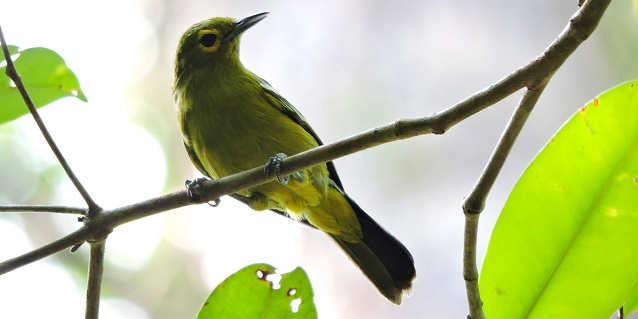2022 RGE Town Hall: A New Golden Era Begins
RGE held its annual Town Hall at the Fullerton Hotel in Singapore on 11 February 2022. Attended in-person by senior leaders in Singapore under safe distancing measures, the 2022 RGE...

Latest updates on what's happening in RGE Group

Editor’s Note: This article was first published on April Dialog. Dr Tony Whitten is Regional Director, Asia Pacific, Fauna & Flora International (FFI). FFI is RER’s technical partner, managing key elements of the project as they relate to biodiversity, climate and communities. As part of its role, it has released an important report, detailing Biodiversity on the Kampar Peninsula. This milestone effort is the result of a series of surveys carried out on the Kampar Peninsula during 2015 to establish an ecological baseline for the purpose of designing and implementing a comprehensive management plan to ensure the long-term protection and restoration of the entire Kampar Peninsula. To mark the release of this report, Dr Tony Whitten, takes a moment to acknowledge the arduous work carried our by FFI’s diligent and committed field teams in the depths of the Kampar Peninsula’s challenging terrain.
Doing broad biodiversity surveys in little-known areas is what many Fauna & Flora International (FFI) staff would love to do, but only a few get the opportunity. Finding, watching, photographing, identifying and reporting on the species in an area is fundamental to understanding how an ecosystem functions and what management steps are needed for its conservation.
As you read through the summary report and look at the beautiful photos the team has taken, spare a thought for what lies behind them. Some were taken with carefully-placed camera traps which lie in wait for a warm-blooded body to trigger the shutter, but many were secured through sheer stealth, patience and skill.
Peat swamp like the Kampar Peninsula is not a great people habitat. It is very hard to walk through: there are many deep streams, the tangle of roots conspires to trip the unwary walker, the peat crust can give way at any time causing the walker to become waist deep in dark brown water, and saw-toothed pandan leaves allow you to walk past in one direction but cut into your skin if you turn back.
When planning the surveys, the sampling transects and quadrats were mapped with nice straight lines. In the field, however, the forest conspires against this. Trees regularly fall across transects due to age, through insecure roots, or through strong gusts of wind. When one tree falls others fall with it, tied together by climbers or simply because they are in the way. The light penetrating to the forest floor starts an intense competition among the small trees and other plants to grab as much light as possible. The vicious pandans proliferate, and progress of the trailblazers is slowed.

Swimming or walking neck high across rivers is part of everyday travel in the Kampar Peninsula peat swamp forest areas, especially for the camera trap team. They float their gear using plastic jerry cans, trash bags, and air-filled wet sarongs.
I’d like to think I know something about such work. When my wife and I were doing our postgrad research over two years on Siberut Island, West Sumatra, we had to contend with an annual rainfall of 4500 mm per year. That’s about the height of a double-decker bus. Our clothes rotted, our boots rotted, we rotted. Every few weeks we had to paint our feet with bright purple potassium permanganate to combat the mould that grew on our feet.
The FFI teams go into the field for two to three weeks at a time. Some of them work during the day, others at night, but whenever they are not directly involved with observations and data collecting, they are writing up the day’s (or night’s) work, backing up and labelling their photos, performing data analyses, and planning routes and tasks for the next day.
Our survey teams cook their own food and everybody joins in the preparation and the clearing up. Our camera trap teams are on the move every day, so their camp stops are very basic and they cook on lightweight and compact alcohol stoves that work well even when it is raining (it’s called ‘rainforest’ for good reasons).
The meals are usually rice, small dried fish, tinned sardines or meat, or pre-cooked rendang, a delicious, slow-cooked beef dish steeped in heavily-reduced coconut milk, chilli and other spices, which lasts a long time without refrigeration. Sweet coffee and tea get the team moving in the morning. There are also candy, chunky chocolate bars and palm sugar as treats. For the team members who have to get up before dawn to census calling birds and mammals there are pre-breakfast crackers and cookies.
At this point we can confirm that the species we encountered are consistent with what one would hope to find in eastern Sumatran peat swamp forests. We know that tigers are present, but the multiple records of the Endangered flat-headed cat are probably more significant. They are known to favor wetlands like peat swamp forests but are rarely encountered. There were also some surprises in finding some rarely seen birds and I’m sure the camps buzzed with excitement when the teams shared their news.
FFI’s work with RER continues. We are surveying the biodiversity in other parts of RER’s conservation estate to build a solid baseline of information and, as the restoration programme progresses, any changes will be monitored.
But, for now, please join me in saluting the young men and women of our field teams!

The camera trap team often slung hammocks between the trees because it was easier and more comfortable than sleeping on the ground or on platforms.